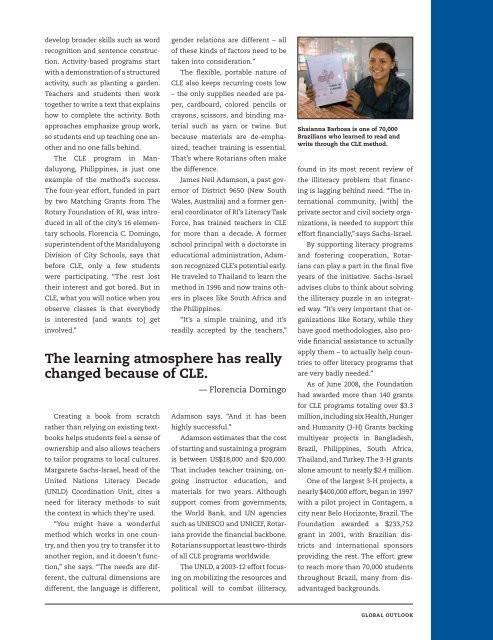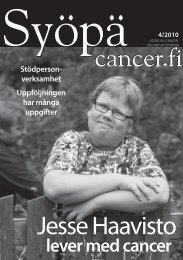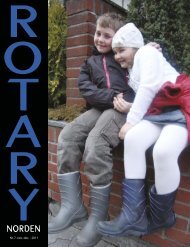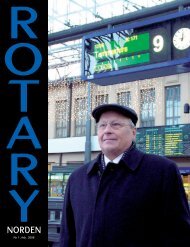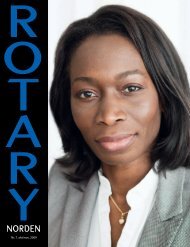Create successful ePaper yourself
Turn your PDF publications into a flip-book with our unique Google optimized e-Paper software.
develop broader skills such as word<br />
recognition and sentence construction.<br />
Activity-based programs start<br />
with a demonstration of a structured<br />
activity, such as planting a garden.<br />
Teachers and students then work<br />
together to write a text that explains<br />
how to complete the activity. Both<br />
approaches emphasize group work,<br />
so students end up teaching one another<br />
and no one falls behind.<br />
The CLE program in Mandaluyong,<br />
Philippines, is just one<br />
example of the method’s success.<br />
The four-year effort, funded in part<br />
by two Matching Grants from The<br />
Rotary Foundation of RI, was introduced<br />
in all of the city’s 16 elementary<br />
schools. Florencia C. Domingo,<br />
superintendent of the Mandaluyong<br />
Division of City Schools, says that<br />
before CLE, only a few students<br />
were participating. “The rest lost<br />
their interest and got bored. But in<br />
CLE, what you will notice when you<br />
observe classes is that everybody<br />
is interested [and wants to] get<br />
involved.”<br />
Creating a book from scratch<br />
rather than relying on existing textbooks<br />
helps students feel a sense of<br />
ownership and also allows teachers<br />
to tailor programs to local cultures.<br />
Margarete Sachs-Israel, head of the<br />
United Nations Literacy Decade<br />
(UNLD) Coordination Unit, cites a<br />
need for literacy methods to suit<br />
the context in which they’re used.<br />
“You might have a wonderful<br />
method which works in one country,<br />
and then you try to transfer it to<br />
another region, and it doesn’t function,”<br />
she says. “The needs are different,<br />
the cultural dimensions are<br />
different, the language is different,<br />
gender relations are different – all<br />
of these kinds of factors need to be<br />
taken into consideration.”<br />
The flexible, portable nature of<br />
CLE also keeps recurring costs low<br />
– the only supplies needed are paper,<br />
cardboard, colored pencils or<br />
crayons, scissors, and binding material<br />
such as yarn or twine. But<br />
because materials are de-emphasized,<br />
teacher training is essential.<br />
That’s where Rotarians often make<br />
the difference.<br />
James Neil Adamson, a past governor<br />
of District 9650 (New South<br />
Wales, Australia) and a former general<br />
coordinator of RI’s Literacy Task<br />
Force, has trained teachers in CLE<br />
for more than a decade. A former<br />
school principal with a doctorate in<br />
educational administration, Adamson<br />
recognized CLE’s potential early.<br />
He traveled to Thailand to learn the<br />
method in 1996 and now trains others<br />
in places like South Africa and<br />
the Philippines.<br />
“It’s a simple training, and it’s<br />
readily accepted by the teachers,”<br />
The learning atmosphere has really<br />
changed because of CLE.<br />
— Florencia Domingo<br />
Adamson says. “And it has been<br />
highly successful.”<br />
Adamson estimates that the cost<br />
of starting and sustaining a program<br />
is between US$18,000 and $20,000.<br />
That includes teacher training, ongoing<br />
instructor education, and<br />
materials for two years. Although<br />
support comes from governments,<br />
the World Bank, and UN agencies<br />
such as UNESCO and UNICEF, Rotarians<br />
provide the financial backbone.<br />
Rotarians support at least two-thirds<br />
of all CLE programs worldwide.<br />
The UNLD, a 2003-12 effort focusing<br />
on mobilizing the resources and<br />
political will to combat illiteracy,<br />
Shaianna Barbosa is one of 70,000<br />
Brazilians who learned to read and<br />
write through the CLE method.<br />
found in its most recent review of<br />
the illiteracy problem that financing<br />
is lagging behind need. “The international<br />
community, [with] the<br />
private sector and civil society organizations,<br />
is needed to support this<br />
effort financially,” says Sachs-Israel.<br />
By supporting literacy programs<br />
and fostering cooperation, Rotarians<br />
can play a part in the final five<br />
years of the initiative. Sachs-Israel<br />
advises clubs to think about solving<br />
the illiteracy puzzle in an integrated<br />
way. “It’s very important that organizations<br />
like Rotary, while they<br />
have good methodologies, also provide<br />
financial assistance to actually<br />
apply them – to actually help countries<br />
to offer literacy programs that<br />
are very badly needed.”<br />
As of June 2008, the Foundation<br />
had awarded more than 140 grants<br />
for CLE programs totaling over $3.3<br />
million, including six Health, Hunger<br />
and Humanity (3-H) Grants backing<br />
multiyear projects in Bangladesh,<br />
Brazil, Philippines, South Africa,<br />
Thailand, and Turkey. The 3-H grants<br />
alone amount to nearly $2.4 million.<br />
One of the largest 3-H projects, a<br />
nearly $400,000 effort, began in 1997<br />
with a pilot project in Contagem, a<br />
city near Belo Horizonte, Brazil. The<br />
Foundation awarded a $233,752<br />
grant in 2001, with Brazilian districts<br />
and international sponsors<br />
providing the rest. The effort grew<br />
to reach more than 70,000 students<br />
throughout Brazil, many from disadvantaged<br />
backgrounds.<br />
GLOBAL OUTLOOK


